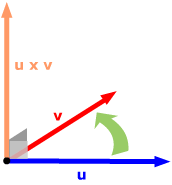Cross products have many properties that make them ideal for certain geometric
applications.
| Calculation rules for cross products |
For any vectors u,
v and w
in 3-space and any scalar c, |
u x 0
= 0, 0
x u = 0
and u x
u = 0
|
u x v
= –(v x u)
(cross products are anti-symmetric)
|
u x (v
+ w) = u
x v + u
x w and
(u + v)
x w = u
x w + v
x w
(distributive rules)
|
c(u x v)
= (cu) x v
= u x (cv)
|
i x j
= k, j
x k = i,
k x i
= j (note the
cyclic i → j
→ k → i
order in each)
|
|u x
v| = |u||v|sin
θ, where θ is the angle between u
and v
|
u x v
is orthogonal to both u and v,
and (provided the coordinate
system is right-handed), u, v
and u x v
form a right-handed system of vectors.
|
:
Most of these rules can be proved by the "brute force" method:
write the vectors in component form, then calculate out the left-hand
side, calculate out the right-hand side and show they are equal.
|
| For the "length" property |u
x v|
= |u||v|sin
θ, first use brute force to prove the Lagrange
identity
(u x v)•(u
x v) = (u•u)(v•v)
– (u•v)2
then substitute (u x
v)•(u
x v) = |u
x v|2,
u•u
= |u|2,
v•v
= |v|2
and u•v
= |u||v|cos
θ to get
|
= |u|2|v|2
– |u|2|v|2cos2θ
= |u|2|v|2
{1 – cos2θ}
= |u|2|v|2
sin2θ. |
Take positive square roots to get |u
x v|
= |u||v|sin
θ. (sin θ ≥ 0 since 0 ≤ θ ≤
π) |
The other rules are straightforward, except for the
last one. It's easy to show by brute force that u
x v is orthogonal
to u and v,
but it's not easy to show that they form a right-handed system.
(This means that, if you curve the fingers of your right hand so
as to push u onto v
through an angle of less than π, your thumb will point in the
appropriate direction for u x
v.) It's important to note that
the original coordinate system must be right-handed as well for
this to be true.
|
 |
|
Notice one multiplication rule that's not included in this list: cross products
are not associative. Here's a counterexample
(an example that shows that something isn't
always true). Calculate:
As we did when we defined dot products, we cheated a bit by using a coordinate
system to define cross products. The last two rules on the list save us this
time by giving us a coordinate-free description of cross products: the cross
product of two non-zero vectors u and v
is the unique vector that:
Since this description gives us both a unique length and a unique direction
for the cross product, it determines the cross product uniquely, and without
using coordinates.

